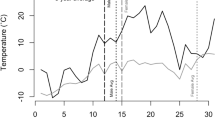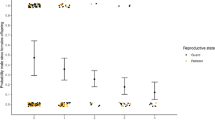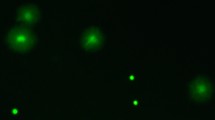Abstract
MALE mate choice is predicted to occur when males transfer nutrients to females during copulation, provide paternal care, or are otherwise limited in mating capacity1–7. Most commonly, field studies have revealed male choice to be focused on females offering high fecundity8–10. Here we describe male mating selectivity that appears to be driven by sperm competition: male thirteen-lined ground squirrels (Spermophilus tridecemlineatus) avoid copulating with previously mated females once the fertilization gain rate drops below the average obtainable from alternative matings. Although this behaviour seems advantageous to males, it limits the duration of female sexual activity.
This is a preview of subscription content, access via your institution
Access options
Subscribe to this journal
Receive 51 print issues and online access
$199.00 per year
only $3.90 per issue
Buy this article
- Purchase on SpringerLink
- Instant access to full article PDF
Prices may be subject to local taxes which are calculated during checkout
Similar content being viewed by others
References
Darwin, C. The Descent of Man, and Selection in Relation to Sex (Murray, London, 1871).
Parker, G. A. Biol. Rev. Camb. Philos. Soc. 45, 525–567 (1970).
Trivers, R. in Sexual Selection and the Descent of Man 1871–1971 (ed. Campbell, B.) 136–179 (Aldine-Atherton, Chicago, 1972).
Dewsbury, D. A. Am. Nat. 119, 601–610 (1982).
Rutowski, R. L. Fla Ent. 65, 72–82 (1982).
Parker, G. A. in Mate Choice (ed. Bateson, P.) 141–166 (Cambridge University Press, 1983).
Forsberg, J. Oikos 49, 46–54 (1987).
Gwynne, D. T. Science 213, 779–780 (1981).
Thornhill, R. & Alcock, J. The Evolution of Insect Mating Systems (Harvard University Press, 1983).
Côte, I. M. & Hunte, W. Anim. Behav. 38, 78–88 (1989).
Parker, G. A. in Behavioural Ecology: an Evolutionary Approach (ed. Krebs, J. R. & Davies, N. B.) 214–244 (Blackwell, Oxford, 1978).
Schwagmeyer, P. L. Anim. Behav. 34, 297–298 (1986).
Schwagmeyer, P. L. & Woontner, S. J. Behav. Ecol. Sociobiol. 17, 291–296 (1985).
Foltz, D. W. & Schwagmeyer, P. L. Am. Nat. 133, 257–265 (1989).
Foster, M. A. Am. J. Anat. 54, 487–511 (1934).
Schwagmeyer, P. L. & Foltz, D. W. Anim. Behav. 39, 156–162 (1990).
Schwagmeyer, P. L. & Parker, G. A. Anim. Behav. 35, 1015–1025 (1987).
MacArthur, R. H. & Pianka, E. R. Am. Nat. 100, 603–609 (1966).
Stephens, D. W. Anim. Behav. 33, 667–669 (1985).
Beach, F. A. Hormones and Behav. 7, 105–138 (1976).
Farentinos, R. C. Anim. Behav. 20, 316–326 (1972).
Packer, C. & Pusey, A. E. Am. Nat. 121, 716–728 (1983).
Hogg, J. T. Behav. Ecol. Sociobiol. 22, 49–59 (1988).
McNamara, J. M. & Houston, A. I. Anim. Behav. 35, 1084–1099 (1987).
Author information
Authors and Affiliations
Rights and permissions
About this article
Cite this article
Schwagmeyer, P., Parker, G. Male mate choice as predicted by sperm competition in thirteen-lined ground squirrels. Nature 348, 62–64 (1990). https://doi.org/10.1038/348062a0
Received:
Accepted:
Issue date:
DOI: https://doi.org/10.1038/348062a0
This article is cited by
-
Mite dilemma: molting to acquire sexual maturity or not molting to ensure durability and dispersal ability in Phorytocarpais fimetorum (Parasitiformes; Gamasida; Parasitidae)
Journal of Ethology (2023)
-
Small males of the fiddler crab Austruca perplexa court more in the off-peak breeding period when large males court less
Journal of Ethology (2021)
-
Polyandry and paternity in a wild population of the swordtail Xiphophorus nigrensis
Behavioral Ecology and Sociobiology (2014)
-
Absence Makes the Heart Grow Fonder: Isolation Enhances the Frequency of Mating in Coleomegilla maculata (Coleoptera: Coccinellidae)
Journal of Insect Behavior (2008)
-
Sex in the dark: determinants and consequences of mixed male mating tactics in Microcebus murinus, a small solitary nocturnal primate
Behavioral Ecology and Sociobiology (2004)



